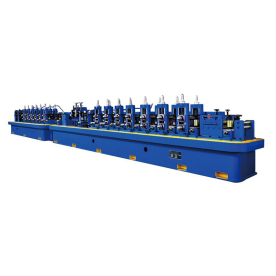[Stainless steel pipe mill production line]An In-Depth Look at the Stainless Steel Pipe Mill Production Line: Revolutionizing the Fabrication of High-Quality Stainless Steel Pipes
News 2024-10-19
The stainless steel pipe mill production line is a sophisticated setup that plays a vital role in the manufacturing of stainless steel pipes used in various industries such as construction, automotive, oil and gas, and many more. In today’s market, the demand for high-quality stainless steel pipes is driven by the increasing need for durable and corrosion-resistant materials. This article aims to provide a comprehensive overview of the stainless steel pipe mill production line, including its components, processes, and significance in modern manufacturing.

An In-Depth Look at the Stainless Steel Pipe Mill Production Line: Revolutionizing the Fabrication of High-Quality Stainless Steel Pipes

An In-Depth Look at the Stainless Steel Pipe Mill Production Line: Revolutionizing the Fabrication of High-Quality Stainless Steel Pipes
1. **Raw Material Supply**: The first step in the production process is the procurement of high-quality stainless steel coils or sheets. The choice of raw material is crucial as it directly impacts the quality and properties of the final product.
2. **Uncoiler**: Once the raw materials are obtained, they are fed into an uncoiler, which unwinds the coils and prepares them for processing. This equipment plays a significant role in ensuring a steady supply of material for further processing.
3. **Forming Mill**: The next essential component is the forming mill. This machine shapes the flat stainless steel strip into a tubular form through a series of rollers. The design of the forming mill allows for adjustable diameters and wall thicknesses, catering to diverse industry requirements.

An In-Depth Look at the Stainless Steel Pipe Mill Production Line: Revolutionizing the Fabrication of High-Quality Stainless Steel Pipes
5. **Sizing Section**: Once the pipes are welded, they move on to the sizing section. This part of the production line helps achieve the precise dimensions of the pipes, including outer diameter and wall thickness, ensuring they meet industry standards.
6. **Cooling Zone**: Following sizing, the pipes enter a cooling zone where they are cooled down to room temperature. This step is crucial to stabilize the material's properties and prepare it for the next stages of processing.
7. **Cutting and Finishing**: After cooling, the stainless steel pipes are cut to the desired lengths, followed by finishing operations. This might include processes such as polishing, surface treatment, or coating to enhance corrosion resistance and aesthetic appearance.
8. **Quality Control and Packaging**: The final stage of the production line involves quality control to ensure that the pipes adhere to relevant standards and specifications. Once inspected, the pipes are packaged appropriately for shipment to clients.
Significance of the Stainless Steel Pipe Mill Production Line
The stainless steel pipe mill production line is significant for several reasons. Firstly, it enables manufacturers to produce a wide variety of stainless steel pipes that cater to different applications. The adaptability of the production line allows for customization based on specifications provided by clients, making it a coveted asset in the manufacturing industry.
Moreover, advancements in technology have led to the development of automated stainless steel pipe mill production lines, enhancing productivity and efficiency. Automation minimizes human error, increases production speed, and reduces operational costs, ultimately leading to higher profitability for manufacturers.
Additionally, stainless steel pipes are increasingly sought after for their durability and resistance to corrosion, which makes them suitable for use in demanding environments, such as chemical processing plants or marine applications. The production line's ability to consistently produce high-quality pipes is essential to meet the rigorous demands of these industries.
Conclusion
In conclusion, the stainless steel pipe mill production line is a complex, yet vital, component of the modern manufacturing landscape. It amalgamates advanced technology with high-quality raw materials to produce durable stainless steel pipes that serve a multitude of applications. As industries continue to evolve and demand more from the materials they use, the importance of an efficient and reliable stainless steel pipe mill production line cannot be overstated. Investing in such technology not only enhances production capabilities but also ensures that manufacturers can meet the growing global demand for high-quality stainless steel products.
